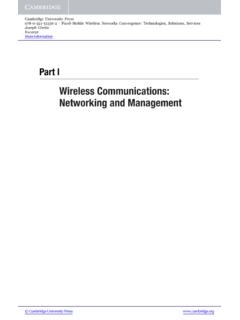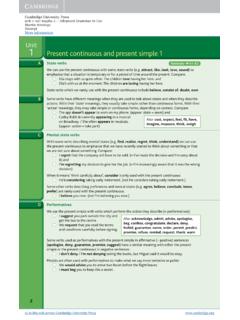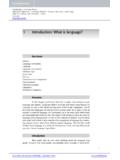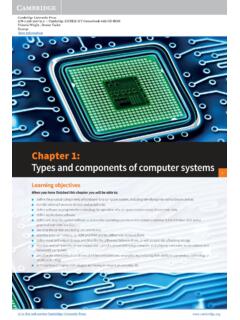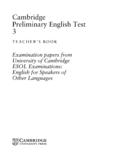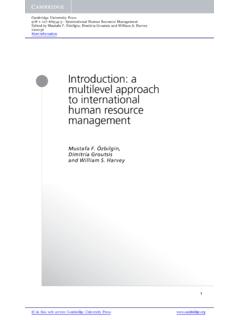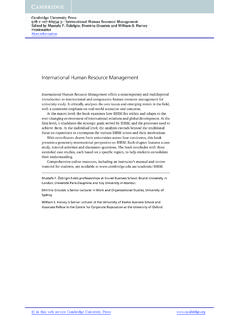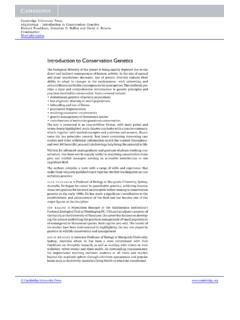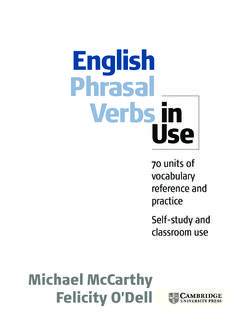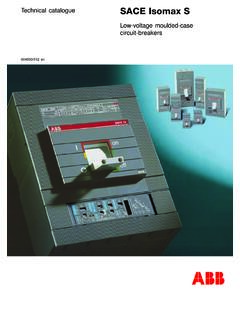Transcription of Cambridge IELTS 4
1 Cambridge IELTS 4 Examination papers fromUniversity of CambridgeESOL Examinations:English for Speakers of Other Languages Cambridge , New York, Melbourne, Madrid, Cape Town, Singapore, S o PauloCambridge University PressThe Edinburgh Building, Cambridge CB2 2RU, on this title: Cambridge University Press 2005It is normally necessary for written permission for copying to be obtained inadvance from a publisher. The candidate answer sheets at the back of thisbook are designed to be copied and distributed in class. The normalrequirements are waived here and it is not necessary to write toCambridge University Press for permission for an individual teacher to makecopies for use within his or her own classroom. Only those pages which carrythe wording UCLES 2005 Photocopiable may be published 2005 Printed in the United Kingdom at the University Press, CambridgeA catalogue record for this book is available from the British LibraryISBN-13 978-0-521-54462-7 Student s Book with answersISBN-10 0-521-54462-9 Student s Book with answersISBN-13 978-0-521-54464-1 Cassette SetISBN-10 0-521-54464-5 Cassette SetISBN-13 978-0-521-54465-8 Audio CD SetISBN-10 0-521-54465-3 Audio CD SetISBN-13 978-0-521-54463-4 Self-study PackISBN-10 0-521-54463-7 Self-study PackContentsIntroduction4 Test 110 Test 234 Test 357 Test 481 General Training: Reading and Writing Test A103 General Training.
2 Reading and Writing Test B116 Tapescripts130 Answer key152 Model and sample answers for Writing tasks162 Sample answer sheets174 Acknowledgements176 Test 1 XLISTENINGXSECTION 1 Questions 1 10 Questions 1 4 Complete the notes NO MORE THAN THREE WORDS AND/OR A NUMBERfor each places which have: historical interest :between and per personNote:special trips organised for groups of :departure reserve a seat:sign name on the 3 days in advanceExampleAnswerNumber of trips per ON SOCIAL PROGRAMMEQ uestions 5 10 Complete the table NO MORE THAN THREE WORDS AND/OR A NUMBERfor each TRIPSP laceDateNumber of seatsOptional extraSt MuseumLondon16th BritainSalisbury18th March50 StonehengeBath23rd further information:Read the or see Social Assistant: Jane 2 Questions 11 20 Questions 11 13 Complete the sentences NO MORE THAN THREE WORDS AND/OR A NUMBERfor each INDUSTRIAL VILLAGE11 Riverside Village was a good place to start an industry because it had water, rawmaterials and fuels such as.
3 And ..12 The metal industry was established at Riverside Village by .. who livedin the were over .. water-powered mills in the area in the 112 Questions 14 20 Label the plan NO MORE THAN TWO WORDSfor each EngineRoomThe ParkEntranceYa theworkersTheStablesTheWorksOfficeToilet sSECTION 3 Questions 21 30 Questions 21 and 22 Choose the correct letter,A, says she has not started the assignment becauseAshe was doing work for another was a really big hasn t spent time in the lecturer says that reasonable excuses for extensions areAplanning with assignment illness or 114 ExampleMelanie could not borrow any books from the library becauseAthe librarian was didn t have time to books had already been 23 27 What recommendations does Dr Johnson make about the journal articles?
4 Choose your answers from the box and write the letters A Gnext to questions 23 and readBusefulClimited valueDread first sectionEread research methodsFread conclusionGdon t readQuestions 28 30 Label the chart your answers from the box below and write the letters A Hnext to questions 28 116 Possible reasonsAuncooperative landlordBenvironmentCspaceDnoisy neighboursEnear cityFwork locationGtransportHrentgg012345610203040 5060708090100 Population studiesReasons for changing accommodationCEG28 ..29 ..30 ..SECTION 4 Questions 31 40 Complete the notes NO MORE THAN TWO WORDSfor each URBAN LANDSCAPETwo areas of focus: the effect of vegetation on the urban climate ways of planning our betterLarge-scale impact of trees: they can make cities more or less in summer they can make cities cooler they can make inland cities more impact of trees: they can make local areas more cooler more humid less windy less trees and buildingsTemperature regulation: trees evaporate water through their building surfaces may reach high temperaturesWind force: tall buildings cause more wind at level trees the wind forceNoise: trees have a small effect on traffic noise frequency noise passes through treesImportant points to consider.
5 Trees require a lot of sunlight, water and to growXREADINGXREADING PASSAGE 1 You should spend about 20 minutes on Questions 1 14which are based on Reading Passage 118 Adults and children are frequently confronted withstatements about the alarming rate of loss of tropicalrainforests. For example, one graphic illustration towhich children might readily relate is the estimate thatrainforests are being destroyed at a rate equivalent to onethousand football fields every forty minutes about theduration of a normal classroom period. In the face of thefrequent and often vivid media coverage, it is likely thatchildren will have formed ideas about rainforests whatand where they are, why they are important, what endan-gers them independent of any formal tuition.
6 It is alsopossible that some of these ideas will be studies have shown that children harbour misconceptions about pure , cur-riculum science. These misconceptions do not remain isolated but become incorpo-rated into a multifaceted, but organised, conceptual framework, making it and thecomponent ideas, some of which are erroneous, more robust but also accessible tomodification. These ideas may be developed by children absorbing ideas through thepopular media. Sometimes this information may be erroneous. It seems schools maynot be providing an opportunity for children to re-express their ideas and so have themtested and refined by teachers and their the extensive coverage in the popular media of the destruction of rainforests,little formal information is available about children s ideas in this area.
7 The aim of thepresent study is to start to provide such information, to help teachers design their edu-cational strategies to build upon correct ideas and to displace misconceptions and toplan programmes in environmental studies in their study surveys children s scientific knowledge and attitudes to school children were asked to complete a questionnaire containing fiveopen-form questions. The most frequent responses to the first question were descrip-tions which are self-evident from the term rainforest . Some children described themas damp, wet or hot. The second question concerned the geographical location of rain-forests. The commonest responses were continents or countries: Africa (given by 43%of children), South America (30%), Brazil (25%).
8 Some children also gave moregeneral locations, such as being near the to question three concerned the importance of rainforests. The domi-nant idea, raised by 64% of the pupils, was that rainforests provide animals with habi-tats. Fewer students responded that rainforests provide plant habitats, and even fewermentioned the indigenous populations of rainforests. More girls (70%) than boys(60%) raised the idea of rainforest as animal , but at a lower level, more girls (13%) than boys (5%) said that rainforestsprovided human habitats. These observations are generally consistent with our previ-ous studies of pupils views about the use and conservation of rainforests, in whichgirls were shown to be more sympathetic to animals and expressed views which seemto place an intrinsic value on non-human animal fourth question concerned the causes of the destruction of rainforests.
9 Perhapsencouragingly, more than half of the pupils (59%) identified that it is human activitieswhich are destroying rainforests, some personalising the responsibility by the use ofterms such as we are . About 18% of the pupils referred specifically to logging misconception, expressed by some 10% of the pupils, was that acid rain isresponsible for rainforest destruction; a similar proportion said that pollution isdestroying rainforests. Here, children are confusing rainforest destruction withdamage to the forests of Western Europe by these factors. While two fifths of the stu-dents provided the information that the rainforests provide oxygen, in some cases thisresponse also embraced the misconception that rainforest destruction would reduceatmospheric oxygen, making the atmosphere incompatible with human life on answer to the final question about the importance of rainforest conservation, themajority of children simply said that we need rainforests to survive.
10 Only a few of thepupils (6%) mentioned that rainforest destruction may contribute to global is surprising considering the high level of media coverage on this issue. Somechildren expressed the idea that the conservation of rainforests is not results of this study suggest that certain ideas predominate in the thinking ofchildren about rainforests. Pupils responses indicate some misconceptions in basicscientific knowledge of rainforests ecosystems such as their ideas about rainforests ashabitats for animals, plants and humans and the relationship between climatic changeand destruction of did not volunteer ideas that suggested that they appreciated the complexity ofcauses of rainforest destruction. In other words, they gave no indication of an appreci-ation of either the range of ways in which rainforests are important or the complexsocial, economic and political factors which drive the activities which are destroyingthe rainforests.
